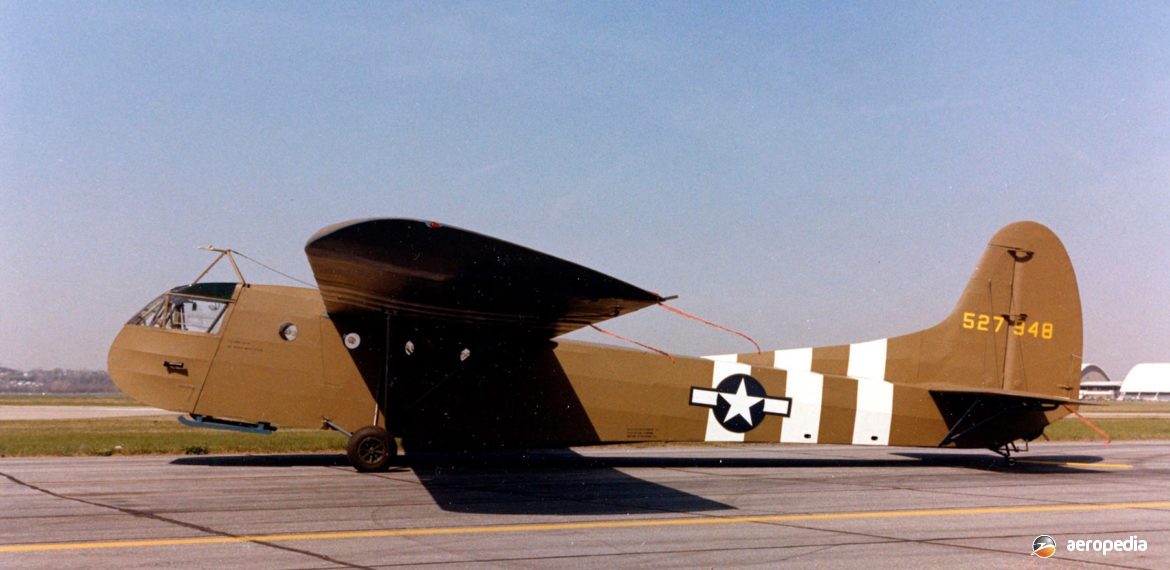Photograph:
Waco CG-4A Hadrian on display at the USAF Museum in Dayton Ohio, USA (USAF Museum)
Country of origin:
United States of America
Description:
Military troop & cargo transport
Power Plant:
Nil
Specifications:
- Wingspan: 25.5 m (83 ft 8 in)
- Length: 14.8 m (48 ft 8 in)
- Height: 4.69 m (15 ft 4 in)
- Wing area: 83.6 m² (900 sq ft)
- Max speed: 241 km/h (150 mph)
- Stalling speed: 79 km/h (49 mph)
- Rate of sink at 96 km/h (60 mph): 122 m/min (400 ft/min)
- Landing run: 180 to 244 m (600 to 800 ft)
- Empty weight: 1,769 kg (3,900 lb)
- Loaded weight: 3,402 kg (7,500 lb)
- Max emergency loaded weight: 4,082 kg (9,000 lb)
- Disposable load: 1,904 kg (4,197 lb)
History:
The Hadrian was designed by the Weaver Aircraft Company (WACO) to meet a requirement of the United States Army. In 1941 the US Army was looking to obtain a range of gliders to meet a number of needs and a number of companies were asked to put forward designs. Waco submitted the XCG-4 and the prototype was allotted the serial 41-29618. The Waco design was the only one to enter production. After trials, a second prototype (42-53534) was ordered. Soon thereafter large-scale production commenced on 16 different production lines and some 12,393 were produced.
The CG-4A was a conventional troop-carrying glider of mixed wood and metal construction with fabric covering, with a high wing and an upward hinged nose section to permit the loading of material and vehicles. With a gross weight of 3,402 to 4,082 kg (7,500 lb to 9,000 lb) it could be towed at up to 241 km/h (150 mph). Production was paramount to meet US Army requirements and they were produced by Cessna [750], Commonwealth [1,470], Ford Motor Co [4,190], G & A Aircraft [627], General [1,112], Gibson Refrigerator [1,078], Laister & Kaufman [310], National [1], Northwestern [1,509], Pratt & Read [956], Ridgefield Manufacturing [162], Robertson [170], Timm Aircraft Corp [433], and Ward Furniture Co [7]. Waco itself produced 1,074.
In July 1943 the CG-4A was first used in the Allied invasion of Sicily but, due to a number of problems which arose, none of which related to the design of the aircraft, the aircraft’s effect on the operation was not great. In operations in Burma in March 1944 they were used in a landing with Colonel Wingate’s Chindits behind Japanese lines, and later on were extensively used in the D-day landings at Normandy in France.
There was not much development of the design during the war years but one example was built of metal by Timm Aircraft as the XCG-4B and one was built as the XPG-1 in 1943 with two Franklin 6AC-298-N3 four-cylinder engines. Another was fitted with two Ranger L-440-11 engines. Waco later developed the XCG-15A with a reduced wingspan, the wing-spoilers being eliminated, a cantilever type undercarriage and other modifications, this being able to be towed at up to 290 km/h (180 mph). Some 427 had been built of a contract for 1,000 when the contract was terminated at the end of the war.
One CG-4A (RAF serial FR579 – named Voodoo) left RCAF base Dorval towed by a Douglas C-47 on 23 June 1943 loaded with 1,524 kg (3,360 lb) of medical supplies, engine parts and radio parts, and crossed the Atlantic Ocean, first landing in Iceland after 7 hrs 15 mins. It continued on to Prestwick in Scotland, total flying time taken for the journey being 28 hours.
A number of Hadrians were imported to Australia for proposed operations in the island hopping campaign, at least 30 examples being shipped to Brisbane, QLD . They were assembled by US crews of the 81st Air Depot Group at Eagle Farm, QLD. They were delivered to the 39th US Troop Carrier Squadron. It seems they received very little use in this part of the world and were eventually stored and retired. However, four were towed to New Guinea carrying US Army engineers where they commenced building an operational airstrip.
It would appear of the CG-4As imported to Australia a few were lost in accidents, one near Mackay, QLD; one in the Samford Valley, QLD and the location of the other is not known but is believed to be in the Brisbane area. After some training the plan was to tow further gliders to New Guinea, a number being towed by Douglas C-47s from Eagle Farm to Townsville, QLD and then they were to cross the Coral Sea to Dobodura, PNG. The gliders were attached to the 375th Troop Carrier Group, 58th Troop Carrier Squadron. A number were to be used in the invasion of Nadzab, PNG and were loaded but the operation with the gliders was cancelled and the operation was carried out with paratroops.
As mentioned, Hadrians were extensively used in operations in the Burma and European Theatres, where a C-47 could tow two gliders, each carrying a pilot and co-pilot. However, in the Pacific Theatre of operations only a single glider was usually towed due to the humidity and heat which reduced the performance of the towing aircraft. The gliders could carry up to 15 fully equipped troops, this including the two pilots. Loads could include a jeep with a crew of three, one 75 mm Howitzer with 25 projectiles and two artillerymen, or a small bulldozer. A couple are known to have been flown north conveying spare Allison engines for Curtiss P-40s. It is believed a number were towed by Curtiss C-46 Commandos.
After retirement many were sold and used for farmers sheds etc. A small number survive in museums in the United States.

